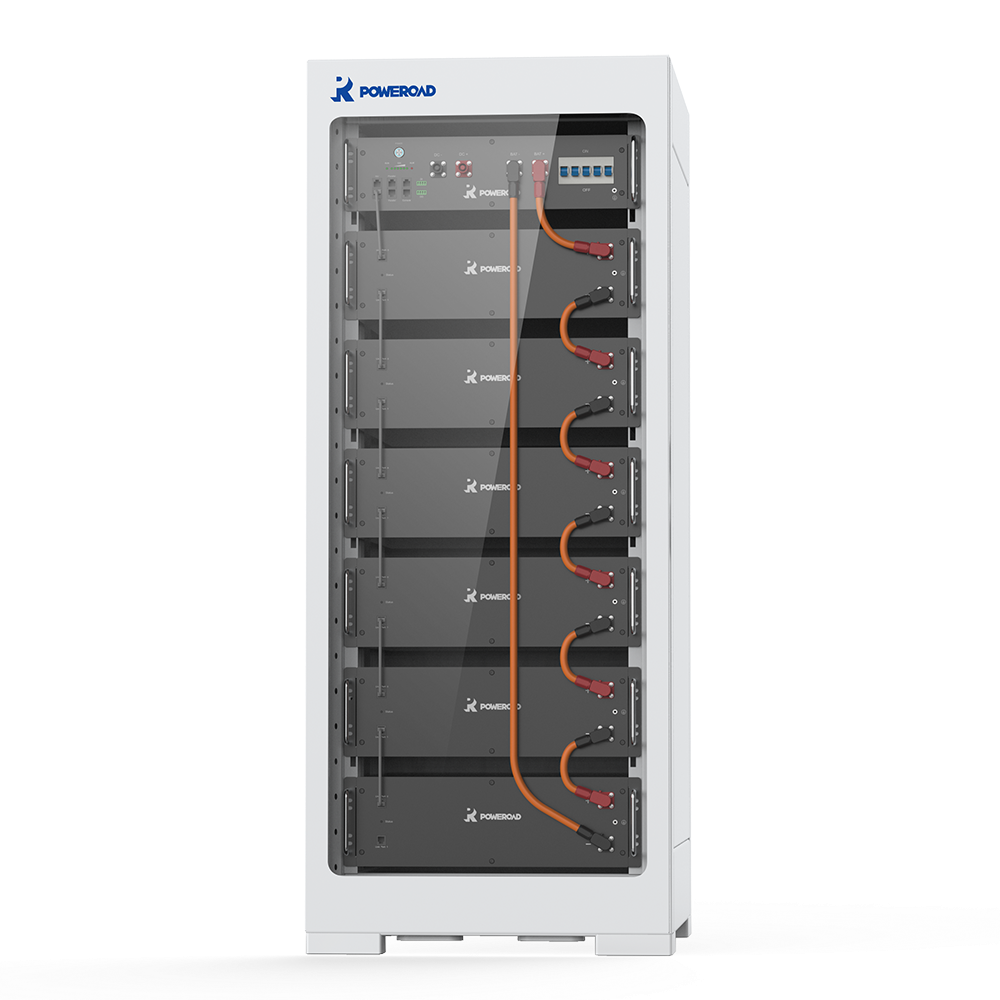

POWEROAD developed and manufactured Backer 2400, the 48V battery backup system. It is a compact package of high energy density and long service life to be applied in a wide range of applications. For wholesale only.
Integrated with highly reliable LiFePO4 lithium-ion battery and Battery Management System (BMS), POWEROAD Backer 2400 can be used to build backup power system for energy desired at your home, to keep your critical devices powered on.
Our Backer 2400 is modular designed low voltage energy storage system. The standardized design offers many advantages, like modular assembly, simple and fast installation and convenient maintenance.
The Backer series uses innovative BMS management mechanism that provides refined management when balancing battery cells. Thanks to the advanced BMS, long service life, high level of safety and excellent reliability are guaranteed for crucial operations, including working as the backup battery system for home.
The Backer 2400 is designed and produced with highest quality and can offer below main features:
● Mature LiFePO4 battery technology ensures highly safety and stability
● Fast charging is available to fully recharge battery within 1 hour
● Parallel connection to increase the system voltage for flexible capacity expansion
● Up to 1C continuous discharge current supports large load
● Can be connected to inverter for on-grid or off-grid applications
● Compact design saves space and light weight makes easy movability
● RS485 and CAN multi communication capability allows compatibility with many devices
● Smart BMS intelligently protects battery from over-voltage, over-charge, over-discharge, over-current, or high/low temperature damage
|
Nominal Voltage |
48 V |
|
Capacity |
2.4 kWh |
|
Charging Voltage |
54V |
|
Charging Current Limit |
10 A |
|
Discharging Cut-off Voltage |
40.5 V |
|
Max. Continuous Charging Current |
50 A |
|
Max. Continuous Discharging Current |
50 A |
|
Weight |
32 KG |
|
Dimension (W x H x D) |
486×133×430 mm |
|
Operating Temperature |
0~45℃ (Charging) -20~60℃ (Discharging) |
|
Relative Humidity |
25%~85% RH |
|
Altitude |
≤4000 M |
|
Communication Interface |
RS485, CAN |
|
Remark |
If need more capacity, module can be connected in parallel max. 8P |
Q1. Do I need backup power supply?
A: Most likely yes if short-term power interruptions or unreliable grid connections happen frequently. The power for backup can be used to protect your sensitive electronic equipment, like your computers
Q2. How to use the Backer 2400 to build a home energy storage system?
A: Our Backer 2400 can be easily assembled in parallel to scale the energy capacity to meet all your home power needs. Connect the Backer 2400 with right inverters, and then a simple home energy storage system is completed. Before choose the right inverters, please check with local distributors.
In an age where energy consumption and environmental sustainability are paramount, the concept of Best home ess has emerged as a transformative force. As homeowners seek to harness renewable energy sources and reduce their carbon footprint, HESS has become a critical component of a more sustainable lifestyle. In this comprehensive article, we will delve into the world of HESS, explore the best options available, and understand the vital role these systems play in shaping a greener and more energy-efficient future.
1.1. Energy Independence
Best home ess systems empower homeowners to take control of their energy production and consumption, reducing their dependence on traditional utility grids. This newfound energy independence provides peace of mind during power outages and fluctuations.
1.2. Renewable Energy Integration
With the increasing adoption of solar panels and wind turbines, Best home ess serves as a bridge between intermittent renewable energy sources and consistent household power supply. It stores excess renewable energy generated during sunny or windy periods for use when needed.
1.3. Grid Support
HESS can provide valuable grid support by participating in demand response programs and supplying stored energy to the grid during peak demand, enhancing overall grid stability.
2.1. Energy Storage Capacity
A fundamental feature of the Best home ess systems is their energy storage capacity. They should provide ample storage to meet the household’s energy needs while allowing for scalability as energy requirements grow.
2.2. Efficiency
Efficiency is critical in Best home ess systems to minimize energy loss during the charging and discharging processes. Leading systems offer high conversion efficiency, ensuring efficient energy utilization.
2.3. Battery Chemistry
Battery chemistry plays a pivotal role in HESS performance and longevity. Lithium-ion batteries, particularly LiFePO4 (Lithium Iron Phosphate) variants, are favored for their safety, durability, and energy density.
2.4. Renewable Energy Integration
The Best home ess systems seamlessly integrate with renewable energy sources, such as solar panels and wind turbines. This integration optimizes the capture and utilization of clean energy.
2.5. Smart Energy Management
Advanced HESS systems often feature smart energy management capabilities, enabling predictive analysis of energy consumption patterns, optimizing charging and discharging cycles, and even participating in grid services to generate revenue.
3.1. Tesla Powerwall
Tesla’s Powerwall is a household name in the world of Best home ess. With a capacity of 13.5 kWh, high efficiency, and robust backup power capabilities, it has gained popularity for its advanced energy management and integration with Tesla’s solar ecosystem.
3.2. LG Chem RESU
LG Chem’s RESU series offers a range of energy storage solutions with capacities ranging from 3.3 kWh to 16 kWh. Known for their reliability and compatibility with various inverter systems, these batteries are a preferred choice for many homeowners.
3.3. Sonnen Eco
Sonnen Eco, a German manufacturer, takes an eco-friendly approach to Best home ess. Their systems feature high-quality LiFePO4 batteries, long cycle life, and intelligent energy management. Various capacity options cater to diverse household needs.
3.4. Enphase Encharge
Enphase’s Encharge series emphasizes scalability, allowing homeowners to start with a smaller system and expand as required. Designed for seamless integration with Enphase’s microinverter technology, these systems are known for their reliability.
4.1. Energy Cost Savings
One of the most immediate advantages of a top-tier Best home ess is reduced energy costs. By storing excess energy during off-peak hours and utilizing it during peak times, homeowners can significantly lower their electricity bills.
4.2. Environmental Impact
By relying on Best home ess to store and utilize renewable energy, homeowners can reduce their reliance on fossil fuels, leading to lower greenhouse gas emissions and a more eco-friendly lifestyle.
4.3. Grid Support
Many advanced HESS systems can provide valuable support to the grid by participating in demand response programs and supplying stored energy during peak demand periods. This enhances grid stability and resilience.
4.4. Backup Power
In the event of grid outages, a dependable Best home ess can seamlessly supply backup power, ensuring essential appliances and systems continue to operate. This is particularly valuable in regions prone to extreme weather events.
5.1. Professional Installation
The installation of a Best home ess system should be conducted by certified professionals to ensure safety and compliance with electrical codes. Expert installers can properly integrate the system with the home’s electrical infrastructure.
5.2. Routine Maintenance
Regular maintenance is essential to maximize the lifespan and performance of a Best home ess. This includes monitoring battery health, software updates, and ensuring proper ventilation and temperature control.
6.1. Technological Advancements
The Best home ess industry is continuously evolving, with ongoing research leading to improvements in battery technology. Future developments may include higher energy density, longer cycle life, and reduced costs.
6.2. Regulatory Support
Governments and utilities worldwide are increasingly recognizing the importance of HESS in achieving clean energy goals. Expect continued regulatory support, including incentives, rebates, and streamlined permitting processes.
6.3. Grid Integration
Best home ess systems will continue to play a crucial role in grid stability and resilience. Advanced grid integration technologies will enable HESS to provide grid services on a larger scale, further benefiting homeowners and society as a whole.
Best home ess are pivotal in the pursuit of sustainable and energy-independent living. The Best home ess systems offer homeowners numerous benefits, including cost savings, reduced environmental impact, grid support, and backup power during outages. As technology advances and regulatory support grows, HESS’s future looks promising.
To make an informed decision, homeowners must assess their energy needs, budget, and available space. Seek professional advice and explore available incentives to choose the best HESS system for your unique circumstances.
By embracing HESS, homeowners not only improve their quality of life but also actively participate in the transition to a cleaner, more sustainable, and energy-efficient future.

Visit us
Email Us
Navigation
QR Code
